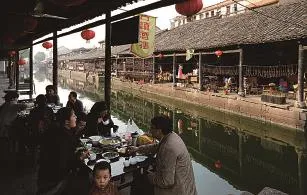The Wine Town
The Wine Town
In Shaoxing, wine yeast and wheat koji are made in lunar July and August, respectively. On Lidong, or the start of winter, raw materials are put into production and the brewing process starts. Pressing and decocting start on Lichun (start of spring) of the following year. At this time of year, along the river banks of the town, you can flnd scenes of winemakers busy flltering and boiling to pasteurise their rice wine.
Text by Wang Yuanchang Photos by Yuan Yun, Wang Yuanchang & Shen Haibin Translation by Leo
在绍兴,农历七月做酒药、八月做麦曲,立冬开酿,到翌年﹃立春﹄时开始榨酒,江南的湖滨水畔一幅幅立体的﹃冬酿春榨图﹄呈现眼前。
酒乡记
The rice wine, featuring a rich, sweet taste, dates back even further than Shaoxing, an ancient town in Zhejiang that has been thriving at its present site for 2,500 years. It is the flrm belief of local people that only the water from Jianhu Lake can produce authentic Shaoxing rice wine. A visit to the centuries-old wine-producing villages that abut on the lake will surely take you back in time and give you the chance to see how wine was purely made by hand in the old days.
Making rice wine by hand is a highly demanding job that requires much physical labour. For the prefermentation stage alone, which is when glutinous rice is added to jars, each jar needs to be stirred over a hundred times a day, and for each stir, oneneeds to overcome resistance equal to a minimum of 25kg. Therefore, as each person takes care of more than a hundred jars every day, accumulatively he is stirring about 250 tons of weight per day. Meanwhile, steamed rice needs to be poured into to fermentation jars. Workers would wheel a “rice barrow” weighing more than 100kg back and forth up to one hundred times a day, amounting to a total distance of 10km a day.
It is by following these seemingly cumbersome procedures that Shaoxing locals produce rice wine true to their tradition, jar by jar.
We were driven to Sun Duan, a town along the banks of Jianhu Lake where the central wine warehouse of Gu Yue Long Shan Shaoxing Wine Co., Ltd. is located. We were amazed by the scale of this world's largest wine warehouse, a Guinness World Records winner. Inside this 150,000 square metre area are over 12 million jars containing tens of thousands of tons of rice wine aged from 5 to 50 years. For these spectacular rows of jars, if they were to be aligned in one line, it would be as long as nearly 8,000km, equal to the distance from Guangzhou to Beijing and back. The wine is breathing and ageing peacefully here. Through the magic of time, it will flnally achieve a flne quality with rich texture, a taste that one will never forget.
Coming back to downtown Shaoxing in the evening, we found a restaurant specialising in local cuisine on Cangqiao Street. We ordered a few signature dishes, including pickled flsh, liquorsoaked chicken, braised pork with preserved vegetables and fried stinky tofu, along with a jar of 10-year-old rice wine. According to the restaurant owner, Shaoxing locals have favoured preserved foods for generations. To make them, rice wine, especially that of top quality, is an indispensable ingredient.
Abounding with water, Shaoxing boasts as many as 10,610 ancient bridges scattered across the old downtown and suburbs. But even more than the number of bridges, the city is home to a wealth of elites, heroes, celebrities, and private advisors for administrative or martial leaders from all dynasties. In addition to famous poets and authors like Lu You and Lu Xun, historical flgures like Xi Shi (one of the Four Beauties of ancient China), Tang Wan and Qiu Jin, Shaoxing has nurtured 60 academicians ( Chinese Academy of Sciences and Chinese Academy of Engineering ) and 4 principals of Peking University.
Another important work about Shaoxing is the Chinese calligrapher Wang Xizhi's semi-cursive script, the The Orchid Pavilion. This piece of artwork, just like the city's reputable rice wine, has been handed down for more than a thousand years and will endure through ages to come.




醇厚甘甜的黄酒,要比这座2500年城址未变的古城绍兴还要悠久。当地人坚信,只有鉴湖的水才能酿出地道的绍兴黄酒。到鉴湖周边那些数百年历史的老酿酒区看上一眼,会让人瞬间穿越回古老的手工岁月。
手工酿酒是强度很高的体力劳动,仅从前发酵阶段,黏黏的糯米饭落缸后计算,每人每天看护着100余缸,每缸一天要搅动上百次,每搅动一次阻力至少25公斤,累计一天要搅动约250吨重量;将蒸过的饭运到发酵缸中,每人每天推着百余公斤的“送饭车”,跑动达百次,路程近10公里。
绍兴人正是用这看起来笨重的传统古法,一坛一坛酿着心底的味道。
我们乘车来到孙端镇,走进位于鉴湖畔的世界最大黄酒酒库、吉尼斯之最的古越龙山中央酒库,感觉只有震撼。总面积约15万平方米的酒库里,1200余万个盛着数万吨绍兴黄酒的大酒坛整齐码放,气势恢弘,如果一字排开可以绵延近8000里。它们在这里均匀呼吸、慢慢成熟,滋生出舌尖上那挥之不去的醇香美味。
傍晚时分,回到绍兴市区,在仓桥直街上找了一家绍菜馆坐下,点了醉鱼、糟鸡、腊肉、霉干菜焖肉、油炸臭豆腐等几个绍帮菜,外加一坛十年陈酿。听老板娘讲,世代绍兴人传承下来的味蕾独钟的腊味,样样都离不开黄酒调制,尤其要用绍兴上乘的黄酒。
没有厚重的文化积淀,哪来醇厚深邃的千年古酒?水网纵横的绍兴,老城和乡下至今保留下来有10610座古桥,而这里孕育的精英豪杰更数不尽也说不完。除了众所周知的书圣王羲之,陆游、鲁迅等大文豪,美女西施、才女唐琬、侠女秋瑾,绍兴还培育了60位两院院士和4位北大校长。
“古来圣贤皆寂寞,唯有饮者留其名。”王羲之因“曲水流觞”而写就的天下第一行书《兰亭序》,与醴郁醇香的黄酒一起,流传千古。

